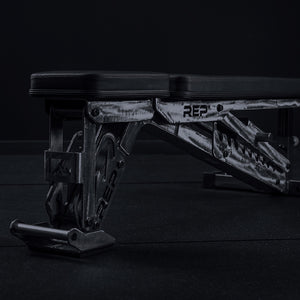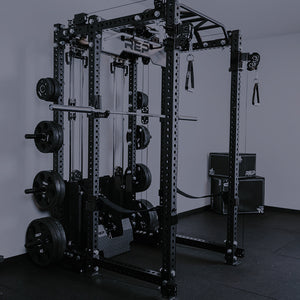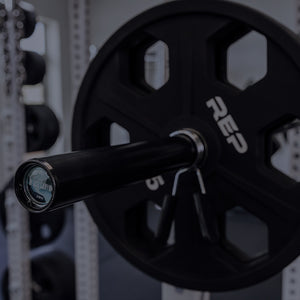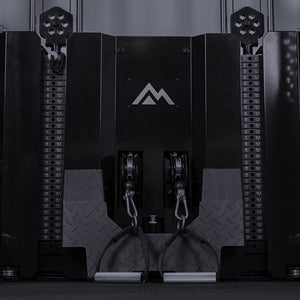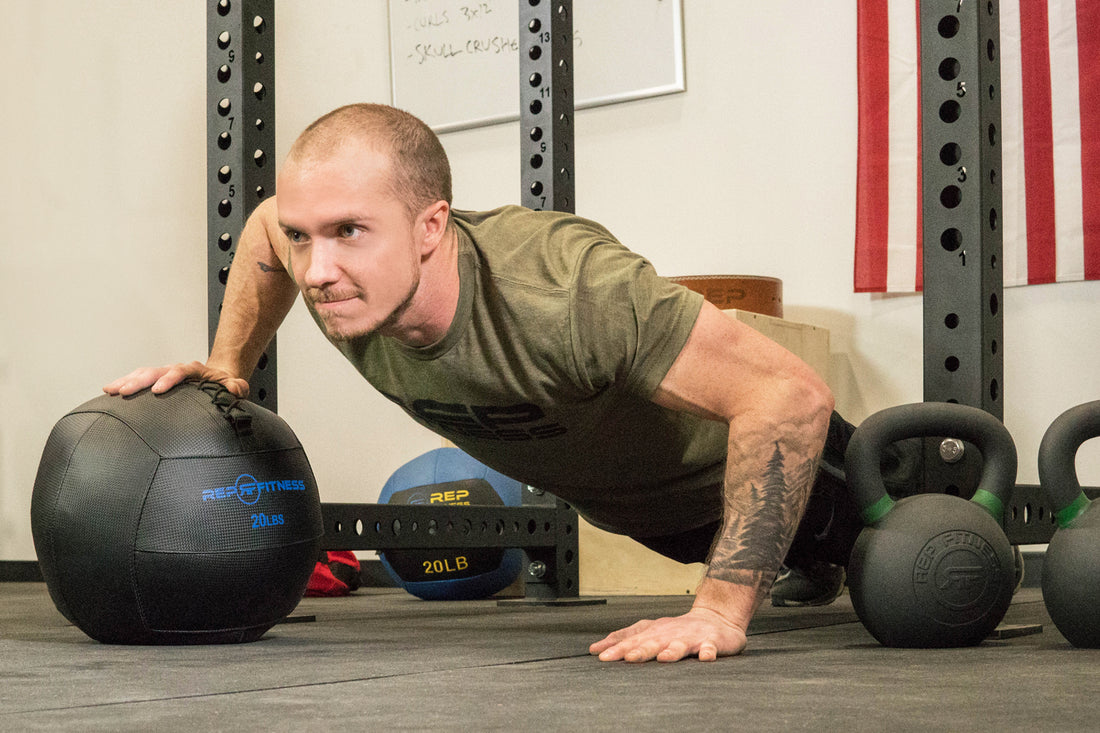
Push-ups are a quintessential exercise -- for their simplicity and effectiveness in building upper body strength. But just because they’re straightforward doesn’t mean everyone can do push-ups correctly, which can lead to less effective workouts and even injuries.
Whether you want to learn how to do a push-up with proper form or you want to master the push-up and do more push-ups, we can help. Here’s a look at:
- the proper form for push-ups
- modified push-ups for beginners
- how to get better at push-ups
- advanced push-up variations
- equipment to improve your push-ups
-
how to incorporate push-ups into your workout routine
The Proper Form of Push-Ups

Before you can improve your push-ups, it's important to understand the basic form:
- Starting position: Begin in a plank position with your hands slightly wider than shoulder-width apart. Your body should form a straight line from your heels to your head.
- The descent: Lower your body by bending your elbows, keeping them at a 45-degree angle from your body. Your entire body should move as one cohesive unit.
- The ascent: Push your body back up to the starting position by extending your arms, while maintaining a rigid torso and straight legs.
Common Mistakes to Avoid With Push-Ups
Improper form not only reduces the effectiveness of push-ups but also increases the risk of injury. Here are some common mistakes to watch out for:
- Sagging hips: This often occurs when your core isn't strong enough to maintain the plank position. Focus on tightening your abs throughout the movement.
- Flaring elbows: Elbows that flare out too wide put unnecessary stress on your shoulders. Aim to keep your elbows at a 45-degree angle.
- Incomplete range of motion: Failing to go all the way down or all the way up can significantly reduce the effectiveness of the exercise.
Common FAQs About Push-Ups
Q: How many push-ups should I do as a beginner?
A: Start with as many push-ups as you can perform with proper form, even if it's only one or two. Gradually increase the number as you get stronger.
Q: What if I can't do a standard push-up yet?
A: Begin with modified versions, such as knee push-ups or wall push-ups, and progressively work your way up to standard push-ups. See the next section for tips on modified push-ups for beginners.
Q: Are push-ups enough for upper body development?
A: While push-ups are effective, they should be part of a balanced exercise regimen that includes both strength training and cardio.
Modified Push-Ups for Beginners

If you're unable to perform a regular push-up, there are several modified versions you can try that reduce the difficulty and strain. These modifications can help you build strength and confidence over time:
1. Knee push-ups: Instead of lifting your entire body off the ground, you lower your knees to the floor. This reduces the weight your arms and chest need to lift, making the exercise significantly easier.

3. Incline push-ups: Place your hands on a raised surface such as a bench, a sturdy table, or even the stairs. The higher the surface, the easier the push-up, as less of your body weight is directed forward.
4. Box push-ups: Similar to incline push-ups but typically using a lower platform – you can adjust the height with Stackable Soft Foam Plyo Boxes. Adjust the height to increase or decrease difficulty.
5. Push-ups against a barbell: If you have access to a gym, you can use a barbell in a power rack set to a low height. Perform push-ups against the bar, which can be raised as you gain strength.
You can also do push-ups on ISO Arms in your power rack and adjust the height as your strength improves.
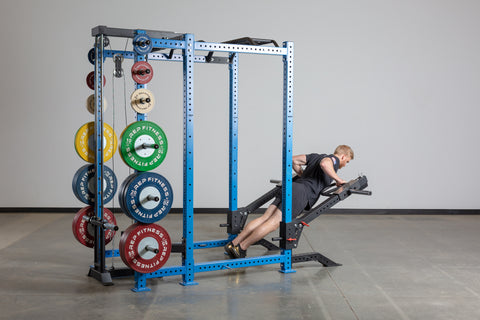
Each of these alternatives helps you work similar muscle groups as regular push-ups but at a reduced intensity. Start with the easiest modification and progressively work toward more challenging versions as you build strength and endurance.
How to Get Better at Push-Ups
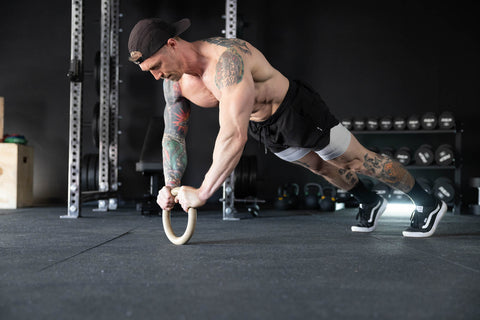
Once you've mastered the basic form, use these strategies to enhance your push-up performance:
1. Improve Your Core Strength
A strong core stabilizes your body and prevents your hips from sagging. Incorporate exercises such as planks, Russian twists, and leg raises into your routine to bolster your core.
2. Develop Shoulder Stability
Shoulder stability is crucial for an effective push-up. Exercises like the plank-to-push-up, shoulder taps, and overhead presses can strengthen the muscles around your shoulders. You can do a ton with a pair of dumbbells.
3. Work on Your Wrist Flexibility
Limited wrist mobility can be a barrier to performing comfortable push-ups. Practice wrist stretches. If wrist pain or mobility is a limiting factor for your push-ups, try doing push-ups while holding Hex Dumbbells. Dumbbell push-ups are a slightly different variation than regular push-ups, though.
4. Use Progressive Overload
To continue making gains, you need to challenge your muscles consistently. You can do this by:
- Increasing reps: Gradually add more push-ups to your sets.
- Adding variations: Introduce variations like diamond push-ups or archer push-ups to target different muscle groups. See below for more advanced push-up variations.
-
Incorporating weights: Carefully placing a weight plate or sandbag on your back can increase the difficulty of your push-ups. You might want a gym buddy to help set it up.
5. Focus on Breathing
Proper breathing is essential for maximizing performance and endurance. Inhale as you lower yourself and exhale as you push back up. This rhythm will help you maintain energy and stability throughout your sets.
Advanced Push-Up Variations
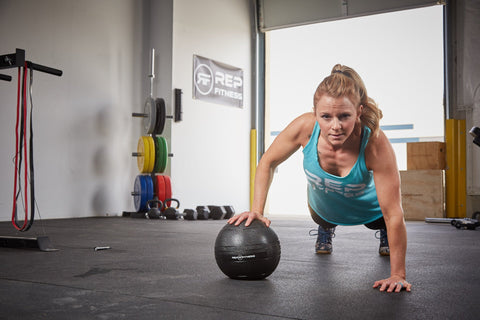
Once basic push-ups become less challenging, try these advanced variations to keep your workouts exciting and effective:
Clap Push-Ups: Add an explosive element to your push-up by pushing up with enough force to clap your hands before landing.
Ring Push-Ups: While balancing on gymnastic rings, perform push-ups. Adjust the difficulty by how steep of an incline you're at.

Spiderman Push-Ups: As you lower your body, bring one knee towards the elbow on the same side. Alternate sides with each rep.
Dumbbell Push-Ups: Using dumbbells in push-ups allows for a deeper range of motion. When you lower your body during a dumbbell push-up, the chest can go lower than the hands if the dumbbells are raised slightly off the ground. This increased range of motion can lead to more significant muscle activation and development, particularly in the chest, shoulders, and triceps. This variation also requires more balance and core stability.
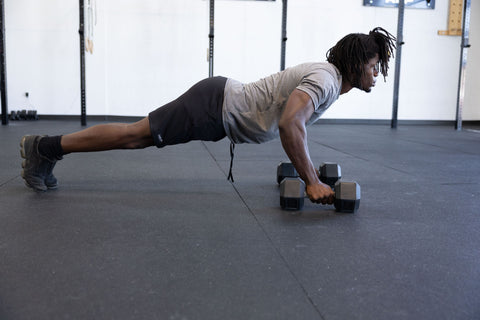
One-Arm Push-Ups: This advanced variation greatly increases the load on your working arm and core. You can tuck one arm behind your back or train toward that by placing one hand on an elevated surface, like a Medicine Ball. Or get extra creative and try to do a single-arm push-up with one hand on the end of a Landmine Attachment.
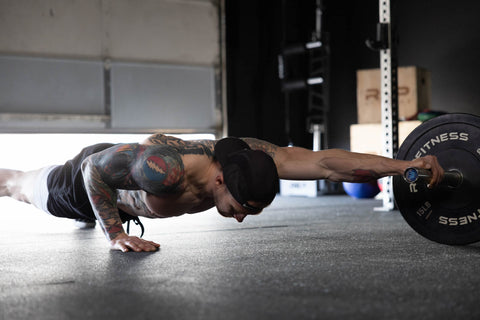
Single-Leg Balancing Push-Ups: Just like you can adjust your arms for your push-ups, you can switch up your legs. Try putting one leg up or placing one foot on a Slam Ball or Medicine Ball while holding the other up.

Balancing Push-Ups: You can do push-ups balancing on certain objects, like placing your hands on upright dumbbells or while holding onto a gymnastic ring.
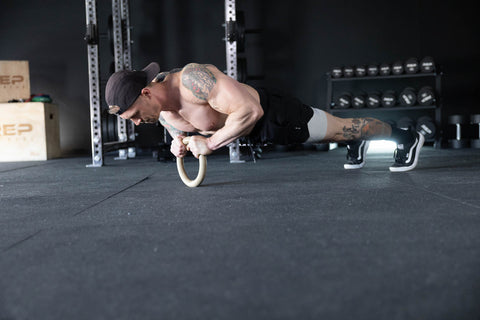
More Equipment to Improve Your Push-Ups
Investing in the right equipment can elevate the effectiveness of your push-ups, add variety to your routine, and help you build strength. Here are some useful tools that can help you enhance your push-up performance:
Resistance Bands
Resistance bands are versatile tools that can be used to add resistance to your push-ups, making them more challenging. By placing a band across your back and under your hands, you can increase the intensity of the exercise as you push up against the band's tension. This is particularly useful for advanced athletes who need extra resistance to continue progressing.
Balance Balls

Using a Balance Ball Trainer can introduce an element of instability to your push-ups, forcing your core muscles to work harder to maintain balance. Flip the balance ball so the round part is on the ground and the flat platform is facing upward. You can either place your feet or hands on the platform, depending on the level of difficulty you wish to achieve. This variation not only strengthens your core but also enhances coordination and balance.
Weights
To increase the intensity of your push-ups, try placing some kind of weight on your back. This forces your muscles to adapt and strengthen as they lift more than just your body weight. It's a simple way to apply the principle of progressive overload, which is crucial for continuous improvement in strength training.
Plyo Box
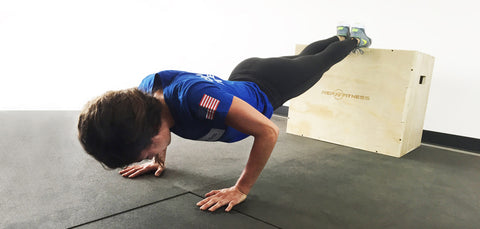
That same box or bench you used to make push-ups easier at the beginning can now make them tougher. Perform a decline push-up, where your feet are elevated on a platform (like a bench, box, or a step), which increases the amount of body weight your upper body has to lift. This elevation shifts more of the load to your shoulders and upper chest, intensifying the exercise. It also requires more core stability to maintain proper form due to the angled position, which further increases the challenge compared to a standard push-up.
Integrating Equipment into Your Push-Up Routine

When incorporating new equipment into your push-up routine, start slowly to get accustomed to the changes in movement and additional strain on your muscles. Here are some tips for integrating these tools effectively:
Start small: Begin with lighter weight/easier challenges (like a resistance band or minimal decline) before moving on to more challenging equipment, like a balance ball.
Focus on form: Always prioritize maintaining proper form to get the most benefit from the exercise and avoid injuries.
Mix and match: Don’t rely on just one piece of equipment. Rotate through different tools to keep your workouts varied and challenging.
By adding these pieces of equipment to your push-up regimen, you can enhance muscle engagement, boost overall strength, and keep your workouts exciting and varied. Whether you're looking to deepen your push-up or add a new level of difficulty, the right tools can help you achieve your fitness goals more effectively.
A Complete Push-Up Workout Routine

Here’s a workout routine that incorporates various push-up exercises and equipment. This routine is designed to challenge different muscle groups and can be adjusted according to your fitness level. Start with sets that you can complete while maintaining good form, and gradually increase the intensity as you get stronger.
Warm-Up (5-10 minutes)
Start with a general warm-up to increase your heart rate and loosen up your muscles. Good options include:
Jogging or brisk walking: 3-5 minutes.
Dynamic stretches: Arm circles, shoulder shrugs, and wrist rolls to prepare your joints.
Push-Up Circuit
Perform each type of push-up for the prescribed number of repetitions, resting 30 seconds between each type. Complete three rounds of the circuit with a one-minute rest between rounds.
Standard Push-Ups: Start with 10-15 reps (or what you can reasonably achieve in one set). Focus on maintaining a straight line from head to heels.
Wide-Grip Push-Ups: Place your hands wider than shoulder-width to emphasize your chest muscles. Aim for 8-12 repetitions.
Diamond Push-Ups: Bring your hands together under your chest so your thumbs and index fingers form a diamond shape. This targets the triceps. Perform 6-10 repetitions.
Decline Push-Ups: Place your feet on an elevated surface like a bench or a box to increase the difficulty. Do 8-12 repetitions.
Balance Ball Push-Ups: Place your feet on a balance ball to engage your core. Complete 8-10 repetitions.
Cool Down and Stretch (5-10 minutes)
Finish your workout with a cool-down period to gradually lower your heart rate and stretch all the major muscles worked. Include:
Chest stretch: Hold each stretch for 20-30 seconds.
Tricep stretch: Each arm should be stretched for 20-30 seconds.
Shoulder stretch: Maintain each stretch for 20-30 seconds.
Tips for Success
Progress at Your Own Pace: If you're a beginner, start with fewer rounds and work your way up. For more advanced lifters, increase the number of reps or rounds to keep the workout challenging.
Stay Hydrated: Drink water before, during, and after your workout to stay hydrated.
Listen to Your Body: Push-ups can be demanding, especially when using variations. If you feel any pain beyond normal muscle fatigue, adjust your technique or switch to a less intense variation.
By following this routine, you’ll not only enhance your push-up skills but also build a stronger, more resilient upper body. The variety in push-up styles ensures that you target all the major muscles in your arms, chest, and shoulders, while also engaging your core, making it a holistic workout suited for anyone looking to improve their fitness.
Bottom Line
Improving your push-ups is not only about increasing the number you can do but also about enhancing your overall fitness and preventing injuries through proper technique. By understanding the fundamentals, avoiding common mistakes, and incorporating the strategies outlined above, you will see significant improvements in your push-up performance and upper body strength. Remember, consistency is key, and every push-up counts toward building a stronger, more resilient you.
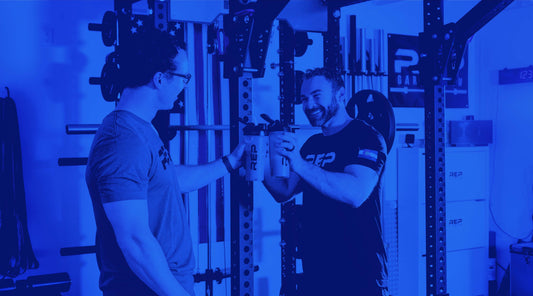
NEWSLETTER SIGNUP
Product launch information, promotions, blogs, and REP news.

